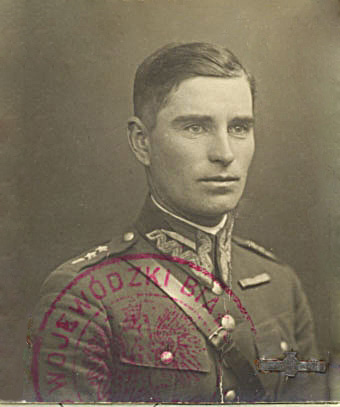
Narcyz Lopianowski,
codname "Sarna"
soldier of Home Army, Colonel.
Biographies of insurgents
Colonel Narcyz Lopianowski, Codename: "Sarna"
 |
Narcyz Lopianowski, |
Narcyz Lopianowski was born on 29th October, 1898 in Lithuania in a village known as Stoki (currently Stakai) in the municipality of Male Soleczniki, county of Wilno. He was the eldest son of Ignacy Lopianowski and Maria Woronko. Growing up in this area was very difficult, as it was for many Poles living under the Russian annexation. Ignacy secretly kept the Polish spirit alive by helping Poles in legal matters, teaching Polish patriotic traditions, as well as the Polish language, which was strictly forbidden under the law of the Russian occupiers.
At a very young age, Narcyz began to help his father by teaching Polish children their native language. As a result of these activities, Narcyz and his family lived in constant fear of the Czar's Police. Eventually, there was a threat of pending arrest so Ignacy had to flee to the United States. In his absence, Narcyz continued to teach the Polish language as well as help Poles who were in need by advocating on their behalf to the Russian administration in Wilno. Ignacy returned from the United States after a few years when Czar Nicholai II declared amnesty.
The First World War ended with an armistice on November 11, 1918. The Russian Revolution started a year earlier. Soon after the start of the Revolution the place of Czarist Russia in the Allied Coalition was taken by the United States which was very advantageous for Poland that was in the process of being reborn. Eight months later, in June 1919, the Treaty of Versailles was signed, on the basis of which Poland was reborn.
Unfortunately, the Eastern borders of Poland were not clearly defined by this treaty because of the continuing Revolution in Russia and demands from Lithuania and Belarus for independence. The conference of the League of Nations in Versailles decided on the 8th of December, 1919 that the Eastern Polish border would be roughly coincident with the line proposed by the English Lord Curzon as representing the border following the third partition of Poland in 1797. At the same time the conference clearly stated that Poland has the right to expand that border.
In the meantime, in 1919, Russia, as it was pushing on the retreating German army, wanted to expand its Western border and so was continuing the war with Poland. First Polish success in this war was freeing Wilno from Russian occupation on April 19, 1919. Among the fighters was a platoon of school children. During the German occupation, Wilno was the seat of the Lithuanian Government but as a result of occupation by the Russians the government was forced to relocate to Kowno. When Wilno once again found itself in Polish hands, Marshall Jozef Pilsudski assured the Lithuanians that they would have self determination rights within the framework of union with Poland. During 1919, along the whole Eastern border, battles continued between Poland and Russia. After the declaration of the 8th of December, it appeared that Poland would be able to retain its allocated borders.
At the beginning of 1920, the Russian army in a great offensive forced the Polish army into a retreat and reached the outskirts of Warsaw. At the same time, in July 1920, Lithuania took advantage of Poland's misfortune and tried to gain Wilno for herself consummating a treaty with Russia. In the middle of August 1920, the Polish army, realizing the strategic plan of Pilsudski and with significant assistance from the volunteer "Blue" army of General Haller, stopped the Russian offensive. During action referred to as "Miracle over Vistula" the Red cavalry of Budienny was routed near Warsaw and pushed back beyond Niemen. Wilno was once again regained for Poland on October 9, 1920 as a result of the action of General Zeligowski. For the longer term this had significant influence on deterioration of relations between Poland and Lithuania. The final determination of the Polish border took place on May 15, 1922 thanks to the intervention of the League of Nations. Poland emerged as an independent commonwealth with borders that remained intact up to September 1, 1939.
During the First World War, Narcyz as a young boy, together with his younger brother, Leon, took part in the defence of Wilno in the battalion formed from school children. In October, 1918 for the first time he took part in a battle with Bolsheviks near his home. After a successful skirmish, Narcyz and his younger brother went to defend Wilno. In April 1919 Bolsheviks attacked the city. During the resulting defense fighting, brother Leon was wounded in his forearm and Narcyz received a bayonet wound. They both lived through this, but because of a lack of specialized medical help, Leon became an invalid resulting from his wounds.
The fighting that took place was very intensive and difficult. It was a very hard experience, especially for young boys. During Easter, 1919, units of the Legions commanded by Jozef Pilsudski came to the aid of the fighting Poles. After two weeks, Narcyz joined the reserve battalion of the 4th Zaniemenski Cavalry Regiment in Bialystok. He was given leadership of his own platoon, and ordered to prepare them for battle as the Regiment was going to march on Wilno. Unprepared and unqualified to train troops, Narcyz began studying military training and tactics. Eventually, the platoon was ready, and the Regiment marched to Wilno.
After the end of this war, "Miracle over Vistula" in 1920, Narcyz Lopianowski decided to remain in the army, continuing his service with the 4th Zaniemenski Cavalry Regiment. Then was sent to the 21st Nadwislanski Cavalry Regiment in Rowne in Wolyn, where he served at different levels of command. In 1927, after completing the military officer's school he was reassigned to the 1st Krechowiecki Cavalry Regiment which received its name from a famous battle near the town of Krechowce. The regiment was stationed in Augustow, the province of Bialystok, and carried the name of Colonel Boleslaw Moscicki.
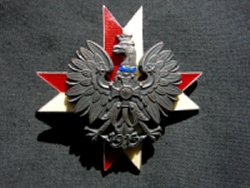
Officer's Badge of 1st Cavalry Regiment of Krechowiecki
Initially the regiment was part of the 1st Cavalry Division and subsequently in the Suwalski Cavalry Brigade. A few years later, Lieutenant Narcyz Lopianowski was assigned to the Heavy Machine-Gun Battalion and over the years from 1927 to 1939, he moved up the ranks of the Regiment, eventually promoted to Captain and becoming 3rd in command of the regiment as well as the Mobilization officer. He was also a famous horse rider taking part in many equestrian competitions.
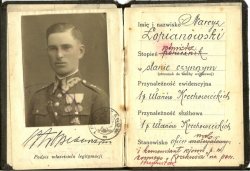
Narcyz Lopianowski's Officer's Certificate
In October 1933, Captain Narcyz Lopianowski married Irena, daughter of Dr. Jan Jaworowski from Augustow. The wedding was held in the Krechowiecki Regiment chapel. Soon they were blessed with two sons. The eldest was Narcyz Marek Lopianowski, and his brother, who was born 2 ? years later, was named Andrzej Jan Lopianowski.
On the 1st of September 1939, at 5 AM, Captain Narcyz Lopianowski heard the sounds of German aircraft flying overhead. The central command in Warsaw had given orders not to shoot at the Germans in order to not irritate the enemy, and the order was sent through to the regiment. However, Captain Narcyz Lopianowski disobeyed this order and commanded his soldiers to open-fire on a large armada of aircraft. They destroyed one German airplane in the process.
With the outbreak of WWII, Captain Lopianowski did his duty as the Mobilization officer, and organized the evacuation of all civilians and military families from the Augustow Regiment Headquarters. Subsequently when a separate 101st Cavalry Regiment was created, he attacked Germans near the Prussian border.
On September 6th 1939 in fights with German airmen in the neighbourhood of Starosielce, Captain Narcyz Lopianowski brought down a ME109 aircraft and damaged another one. In the night of 6-7th September 1939, the 101st Regiment whose second squadron was commanded by Captain Lopianowski, moved to Wolkowysk where they were joined to the operational group "Wolkowysk" commanded by Gen. Przezdziecki.
On September 17th 1939, Poland was unexpectedly attacked from the East by Soviet Russia. Following the orders of the Supreme Commander, Marshall Edward Smigly-Rydz, majority of the Polish units did not engage in battle with the Soviet Army. Nevertheless, units of the Border Defense Corp (KOP) and some of the units and garrisons, including in Grodno, Wilno, and the operational group of "Wolkowysk" offered resistance. Following the initial successes, e.g. the victorious battle of Kodziowce against overwhelming enemy forces, the fighting units were forced to cross the borders of the Baltic Republics, where Polish soldiers were interned.
After defeat of KOP and other improvised Polish military units, the Red Army reached the line of Narwia, Bug, Wistula, and San. The final skirmishes between KOP and Soviet Forces took place near Szack on September 29-30th and Wytyczny on October 1st 1939.
Historians estimate that the casualties, in the fighting with the Red Army, mainly those shot after being taken prisoner or those that were wounded included several thousand Polish soldiers. The numbers of prisoners are estimated at around 250,000. Casualties of the Red Army according to the statistics provided by the Government of the prior USSR amounted to 2,500 killed and wounded.
From the first group of Polish officers taken prisoner by the Russians, majority were murdered during April and May 1940 in Katyn and other prisoner camps. Officers that were interned in Lithuania and other Baltic States were able to avoid the fate of this first group. Following occupation by Russia, Polish officers from the units interned in the Baltic Republics were transported as prisoners to Kozielsk in June 1940, thus following the Katyn murders.
On September 20th 1939, the first military encounter of the 101st Reserve Cavalry Regiment with the Bolsheviks took place near the village in Dziebrowo. The cavalry charge destroyed a number of Soviet infantry while the Russian tanks were forced to retreat. In the evening hours of September 21st the Regiment entered Grodno, supporting the Poles who were fighting there against the Bolshevik tanks and infantry, and set up barricades against tanks on the bridges. Using the only regimental anti-armour gun, Captain Lopianowski damaged a Soviet tank near the railway bridge. The fighting in the outskirts of Grodno lasted till midnight of the 21st September, but because of the pressure of the Russian units, Polish forces could not hold and an order was given to retreat to the area of Kodziowce near Czarna Hancza. After crushing the defenders of Grodno, Soviets, during the days of September 21st and 22nd, shot and killed about 300 Poles, including teenage boys. This was the harbinger of the repressive activities of the Soviet Government against Polish population in the terrains of the Commonwealth of Poland occupied by Russia.
On September 22nd 1939 took place the battle of Kodziowce. The Red Army threw 40 tanks against the Polish Cavalry Units of which 23 tanks where destroyed. In fierce fighting, Russian infantry casualties were significant. Polish sources do not provide an actual number of killed, but Russian sources list them a 800, perhaps history one day will reveal to us the number of killed Soviet soldiers. The entire 101st Cavalry Regiment was engaged in the fight.
The second squadron, commanded by Captain Lopianowski, in heavy fighting suffered great losses, half of the squadron lancers died. It was there that Captain Lopianowski suffered a battle wound in his foot. The battle of Kodziowce is considered by historians to be the greatest victory in the Polish-Soviet War of 1939.
Despite this success, the Red Army was advancing with strength and the 101st Cavalry Regiment together with Captain Lopianowski was forced to retreat into Lithuania. During the night from September 23-24th 1939, the 101st Cavalry Regiment crossed the Lithuanian border. There the regiment was interned. The officers were quartered in internment camps in Kalwaria and Rakiszki. In June 1940, Russia overthrew the governments of the Baltic Republics and annexed their territories. The Polish Military internees were moved to an existing but empty (after carrying out, during April-May 1940, the Katyn massacres) N.K.V.D. camp in Kozielsk. 859 officers were transported from Lithuania. On June 11th arrived the officers from the 101st Cavalry Regiment.
Sorting of prisoners took place in these camps leading to a selection of those officers that were prospects for cooperating with the Soviets. Arrests were also being made. On September 20th 1940, Captain Narcyz Lopianowski together with 20 other selected officers including Gen. Przezdzicki was transported to a prison in Moscow. After a short inquest Gen. Przezdziecki together with Captain N. Lopianowski and 9 other officers, were transferred to the Łubianka prison, the headquarters of the N.K.V.D. For several months, they were interrogated by the Chief of Staff of the N.K.V.D., Lieutenant Colonel Jegorov. On the 25th of December, 1940, Captain Lopianowski, along with other officers were escorted to a villa outside Moscow, called Malachowka. In the villa referred to as the "Villa of Delights" took place brainwashing with participation of former Polish Officer, Colonel Berling. Prisoners were encouraged to take up cooperation with the Russians. Sadly, majority of the officers agreed. However, Captain Lopianowski and one other officer, Major J. Lis, refused. As a result, they were sent back to Łubianka, where they joined Col. Kunstler Stanislaw, Col. Morawski (retired) and Lieut. Tacik. Details of the stay in Lubianka and Malachowka are written up in a book by Narcyz Lopianowski "Rozmowy z NKWD 1940-1941".
In April 1941 as a result of their refusal to cooperate with the Russians, Captain Lopianowski, together with General Przezdziecki and several other officers were taken by train to a monastery in Werba in the Ukraine, then to Griazowiec near Wologda. In June 1941, following the outbreak of the Russian-German War, some prisoners from Kozielsk were evacuated to Griazowiec. The remaining prisoners were taken beyond the arctic circle to forced-labour camps. This fate affected about 4,000 of the interned prisoners.
On August 12th 1941, a decree was announced about the amnesty for Polish citizens. It directed release of the war prisoners. Soviet Government released key leaders from prison, enabling forming of an army under General Anders. Captain Lopianowski and other officers were also released. Shortly they were integrated by General Anders into the forming Polish Army and given commanding posts. Captain Lopianowski was appointed to the Divisional Staff of the 5th Infantry Division, and in January 1942, he helped to form the new 8th Infantry Division under the command of Gen. Rakowski.
General Anders army made its way from Russia through Iran (Persia at that time) to the Middle East, and functioned as the 2nd Polish Corp under British Command. In total about 41,000 military and 74,000 civilians left Russia. In the Middle East, Captain Lopianowski was approached by officers of the British Intelligence with an offer to serve in British Special Forces (S.O.E. - British Special Operations Executive). He accepted and was sent to England. But prior to that, he traveled to South Africa to take on oversight of a group of German prisoners while they were transport by boat to Halifax, Canada, to a prisoner's camp.
He completed his mission and in October, 1942, reached Britain where he was trained by the S.O.E, promoted to Major, and joined the Cichociemni (literally: "Silent & Unseen"). At this time, he was also given the codename: SARNA (named after his favorite horse from the 1st Cavalry Regiment).
As a member of the S.O.E. Polish Special Forces under British command, Major Sarna fought in Italy and North Africa until the end 1943. In September 1943, Major Sarna was sworn into the ranks of the A.K. (Polish Underground Army) and after receiving new orders he was dropped at the rear of the German Front in Poland as part of operation "Wildhorn I - Bridge I" during the night of April 15-16th 1944, undertaking the struggle jointly with the Polish Underground Army. He was directed to Warsaw where, after acclimatizing, in May of 1943, he was appointed deputy-commander to Major Stanislaw Letowski's "Mechanik", Armoured Headquarters Command of Polish Underground Army, District of Warsaw. At that time he used the adopted name of Stanislaw Wilczek.
In the Warsaw Insurrection, he first commanded a sector part of the armoured group in Region 2 of the downtown core. Later he was the staff officer of the Downtown South-Core. In August 28, 1944 he assumed command of the Northern Area of Downtown-South referred to as "Sarna" Sector, having under him the Battalions of "Belt", "Sokol", "Stefan", and "Chrobry" PAL and also the company AL "Gustaw". The area of the Sarna sector was bounded by the following streets: Marszalkowska - Wilcza - Plac Trzech Krzyzy - Nowy Swiat - Al. Jerozolimskie.
He was twice wounded, first on August 21st (near Wilcza Street) and then again on September 11th (near Zurawia Street). Three times he was put forward for promotion to Lieutenant Colonel, but the requests were not approved because of the specific situation during the Uprising. Decorated with the cross of Virtuti Militari - Vth Class (personally on the battle line by the Commander of the AK - Polish Underground Army, on September 22nd 1944) and with the Cross of Valour through an order dated October 1, 1944. His wife, Irena, also took part in the Warsaw Insurrection with the rank of Second Lieutenant in the AK
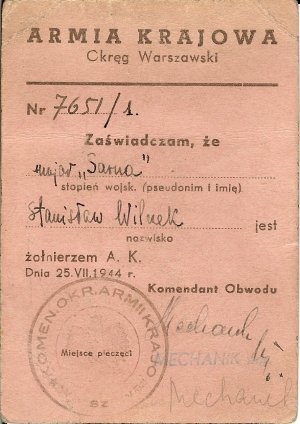
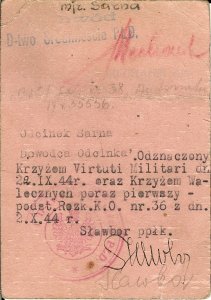
Narcyz Lopianowski's AK Certificate
With the surrender of the Polish Insurgents in October, Major Sarna was taken as a Nazi Prisoner of War to Germany. In May 1945, he was released, and rejoined the Polish Army where he was promoted to Lieutenant Colonel. Then in September 1946, he moved to England where he was posted with the Polish Resettlement Corps until September 1948.
For his achievements, he was decorated with numerous orders and medals, both Polish as well as foreign. A number of the Polish decorations were given to him after the war by the Polish Government in Exile in recognition of his contribution towards upholding the Polish cause.
Following discharge, Colonel Sarna was forced to earn a living but severe concussions and contusions from shell-shocks during the Warsaw Uprising, left him an invalid and unable to work.
While living in England, Colonel Sarna and his wife Irena, were blessed once more with the birth of their third child, Elzbieta Lopianowski. In April 1958, Colonel Sarna, together with his wife and young daughter came to Canada as their son, Narcyz Marek Lopianowski, was already living there. Initially he lived with his family in Montreal and later moved to Vancouver, on the Western Coast of Canada.
Colonel Narcyz "Sarna" Lopianowski died on June 20th, 1984 suffering towards the end of his life from ailments mainly resulting from injuries he obtained during the war. He never lived to see the country he had fought so hard to protect regain its freedom. His wife, Irena Lopianowski, died three years later on October 17th, 1987 and was laid to rest next to her husband.
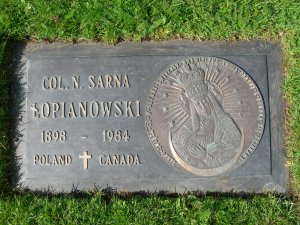
Narcyz Lopianowski's Tombstone Plaque
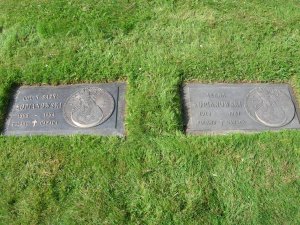
Narcyz & Irena Lopianowski Tombstones
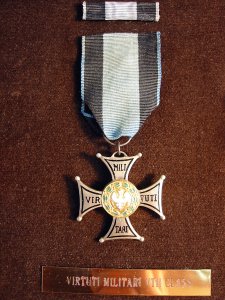
Narcyz Lopianowski's Virtuti Militari
Andrzej i Marek Łopianowscy
Copyright © 2005 Maciej Janaszek-Seydlitz. All rights reserved.